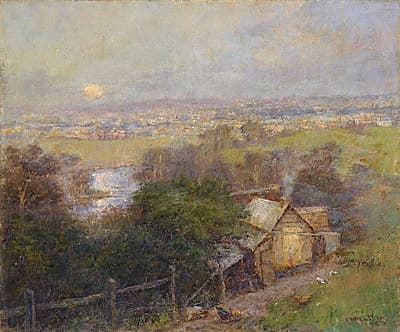Frederick
MCCUBBIN
Australia
1855
–
1917
Moonrise
1909
oil on canvas
signed and dated 'F. McCubbin/ 1909' lower right
77.0 (h)
x 92.0 (w)
cm
National Gallery of Victoria, Melbourne
purchased with the assistance of a special grant from the Government of Victoria, 1979
Moonrise is one of the most poetic of McCubbin’s many paintings of the view from his home in South Yarra. In it he combines many of his favourite motifs—moonrise, a distant view of houses, the Yarra River, a dilapidated fence, a rustic cottage, and feeding chickens—into one glorious composition that gives full expression to his intense affection for this scene.
McCubbin has used an almost square format, coarse-weave canvas for this work. The image is broadly divided into the conventional one-third sky, two-thirds land formula. Of more significance is the extraordinary contrast between the upper and lower halves of the composition. The lower half, already in shadow, is a close-up view of the fence, chickens and cottage. The mood is intimate and enclosed, a cosy domestic scene. In contrast, the upper half is a pure landscape, still lit by the last rays of the sun, featuring a distant view of hills and the rising moon. Remarkably, both the upper and lower half of the work are complete compositions in themselves, yet McCubbin has managed to unite these by leading our eye in a serpentine movement from the lower left of the painting, along the fence to the cottage, and back along the banks of the Yarra towards the moon in the top left, which becomes the focal point of the work.
The extent to which this is a carefully crafted image rather than a straightforward rendering of the view is revealed by a comparison of Moonrise with a pencil drawing in McCubbin’s sketchbook Gardener’s cottage, Como (cat 19)
and with the smaller painting The old cottage, South Yarra c 1910 (private collection). In both the drawing and the painting the cottage is depicted from the same vantage point as in Moonrise, but in both works the river is not visible but implied; instead, there is a view looking across ‘Como’ to the houses on Williams Road.
The McCubbin family moved to ‘Carlesberg’ at 42 Kensington Road, South Yarra in 1907, shortly after McCubbin’s return from overseas. Originally known as ‘Bona Vista’, this house was built by Dr Edmund Charles Hobson c 1846–48, set on 27 acres (11 hectares). It was one of the earliest houses in Melbourne, and consisted of approximately 10 rooms and a verandah. By the time the McCubbins lived there, the property had been reduced to approximately three acres and ran from Kensington Road down to the Yarra. On the right it shared a boundary with the grand ‘Como’ estate, owned by the Armytage family. The fence in Moonrise marks the border of the property with ‘Como’, and the cottage depicted was the ‘Como’ gardener’s cottage. This cottage, one of McCubbin’s favourite subjects, features in a number of works from this time, including The cottage children (Rain and sunshine) (cat 37).
Moonrise was warmly received when first exhibited at the Victorian Artists’ Society winter exhibition in 1909 (cat 77 – £157.10.0), with one critic commenting:
Mr McCubbin has found material in plenty in Melbourne’s old gardens overlooking the Yarra, and what are, to most people, the prosaic flats of Richmond ... Moonrise seems to breathe the very spirit of twilight, the pale moon glowing in a mist above a fast disappearing landscape of river, warm-tinged foliage, and township beyond (Age, 15 July 1909, p 8).
Elena Taylor
